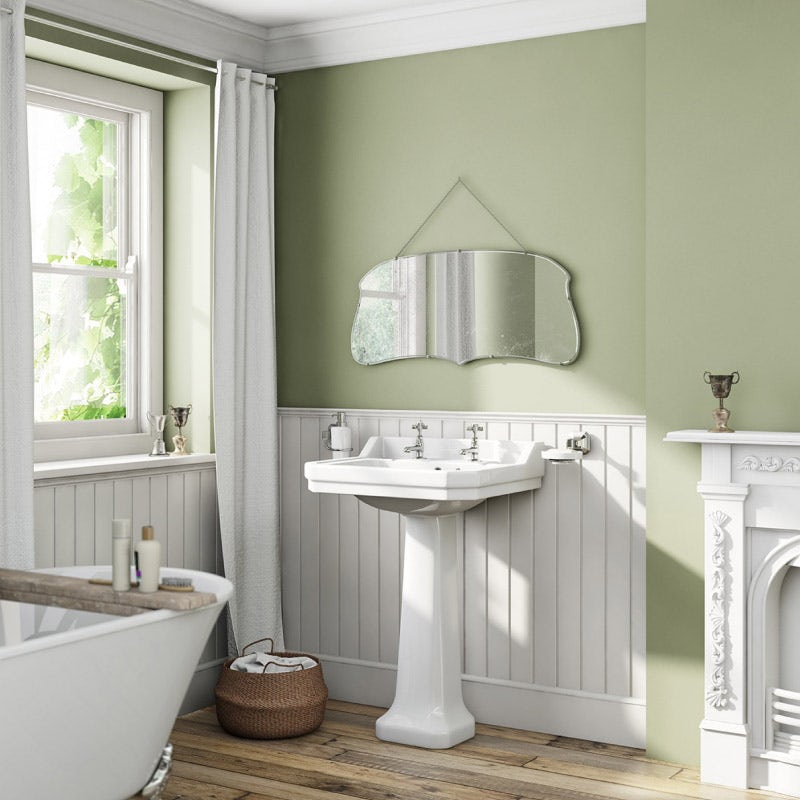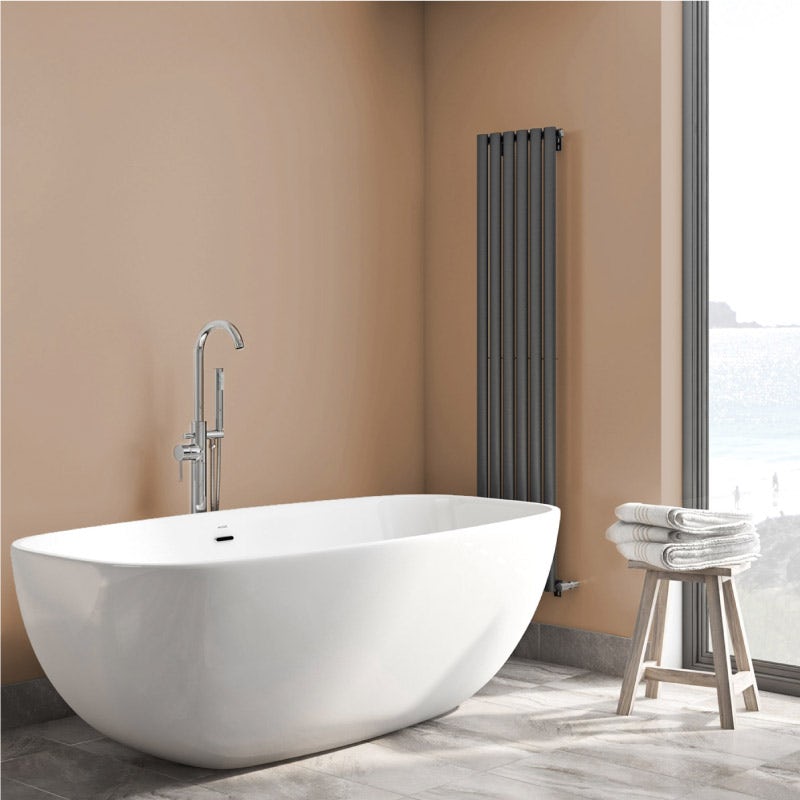Flat Or Satin Paint For Bathroom
Flat Or Satin Paint For Bathroom

DIY Advice
Which paint should I use in a bathroom?
Posted by Adam Chard in DIY Advice | 1 year ago 7 min read
Painting your bathroom throws up some unique challenges which you won't experience in other parts of your home. In this article, we look at the types of household paint available to you and which you should choose to decorate your bathroom.
When it comes to decorating, there are few rooms in your house as challenging as the bathroom. Frequently filled with steam, this is an area that is not only wet but also tends to be cleaned with some of the harshest chemicals, so almost everything that goes in there–including your paints and finishes–needs to be able to deal with these things in a sustained way.
Paint manufacturers used to recommend that you used something tough, such as a well-primed gloss topcoat on your wood and an emulsion on your walls, and be prepared to replace them every year or so as moisture took hold. But the nature of our bathrooms has changed and we are now more likely to have a hot shower rather than a tepid bath, and so the tendency for steam to linger has increased.
An increasing number of us also tend to wash and bathe our pets in our bathrooms, leading to more slopped water than is usual. While no one would suggest anything other than sturdy tiling in a wet room or shower area, that is rarely effective throughout the room, and painted walls are commonplace.

Mildew and mould-resistant paint
Before paints with mildew-resistant properties were freely available on the market, it was usual to use a simple, very high-gloss paint as an effective way of dealing with moisture that builds up in a bathroom. The higher the gloss factor of a paint, the better it usually tends to perform in a damp bathroom environment. The unfortunate fact is that general gloss paints do not prevent mildew per se, but the glossiness does make it easier to wipe down the brown stains and mildew, that characterise many older bathrooms.
Modern paints are typically mould and mildew-resistant and encapsulate an advanced biocide technology designed to actively fight all common types of fungal growth, preventing them from gaining a foothold for up to 6 years.
Bespoke bathroom paint is specially designed for use in normally damp areas and incorporates mildew-inhibiting properties. However, the downside is that bathroom paint can be significantly higher priced than ordinary interior latex-acrylic paint, and can be close to double the cost, making decorating your bathroom with these a potentially expensive business.
What type of paint can I use in the bathroom?
Ideally, you do need to use a range of paints in a bathroom and there are many alternatives to choose from, it can be difficult to know which ones are best for your needs, so here's what you need to know to help you make the right choice:
- Flat. Typically, a smooth matt coating, but probably best in lower-traffic areas where it does not get scuffed easily. It's suitable for most rooms but it tends to absorb moisture, so is not ideal for bathrooms or kitchens.
- Eggshell. A slight sheen and more washable and scrub-able than flat. Acrylic Eggshell is suitable for bathrooms and kitchens.
- Satin. Satin has a little bit of a gloss, and can be used in low-moisture bathrooms, but is not very good in higher than average damp.
- Semi-gloss/High-gloss. This type works well in the bathroom because the gloss repels moisture well. The downside is that gloss does not look good over large surfaces such as walls. It is best used for smaller surfaces like trim, cabinets, widows, and almost any woodwork that you want to protect.
So, in many cases, you do not need to buy speciality mould and mildew inhibiting bathroom paint. Just remember to keep your bathroom well-ventilated. A modern formulated paint like an acrylic eggshell or satin finish paint is fine for most bathrooms, though that does depend upon just how damp your bathroom gets. All of the above paints will repel surface moisture to some degree, but more sustained damp environments, where drops of moisture are likely to linger, you definitely need something with more protection, and that generally means using a specialist paint (like Craig & Rose 1829 from VictoriaPlum.com).

How do I apply paints in a bathroom?
Painting a bathroom can be started from 2 different viewpoints; it can be started completely afresh and with newly plastered walls, or it can be started from the point where there is existing paint, and they need to be treated in different ways.
If you have had a wall replastered, or you even have an unfinished new build, you will be in a position to start completely afresh, however, that doesn't necessarily make the task any easier. You need to ensure that the plaster is completely dry and free of dust and flaking.
Next, you need to apply a "mist" coat of paint. This is prepared by adding water to a cheaper emulsion paint in a similar colour to your topcoat. The ratios for this will vary but around three parts paint to one-part water should suffice. Apply this to the wall and allow it to be absorbed into the fresh plaster. This initial coat will act as a primer and once it is completely dry, you can apply the top coat of your choice and allow it to dry. You can apply a second coat if you think it needs it. This should now be a well-founded surface.
If you are repainting a previously painted wall, you need to look for any cracks and imperfections and apply a suitable filler to them (see our handy video below).
This should be allowed to completely dry before you sand the area down using fine sandpaper. Once that is done, you should wash down the whole wall (or walls) with sugar soap. This will take off any small imperfections and will also remove grease spots as well. By doing this to the wall, you will allow the paint to apply without any small defects which may later allow moisture to gain a foothold under the paint and undermine it.
Other considerations
But supposing that you can't get an anti-mould paint in the colour or hue that you really want? No problem—just add one of the many specialist additives that can be included in almost any paint you want to apply to your walls.
There are a huge number of different products of this nature and there will be something that is suitable for the type of paint that you are considering. And since they do not affect colour—though they will water the initial paint down slightly since they are usually mixed at the rate of 100ml per 5 litres of paint—and are usually white. If you have a specialist colour, be aware that the darker your colour is, the more effect adding the white content will have on it.
Wrapping it up
- Emulsion-type bathroom paints for walls are not usually waterproof, though eggshell paints are based on polymers (acrylic), and are to a limited degree.
- You can apply virtually any paint to bathroom walls and woodwork.
- Anti-mould paints inhibit the build-up of fungi.
- You can make any paint anti-fungal by adding specialist products.
- Any bathroom or toilet area has a higher incidence of moisture and should be treated in the same way.
- When decorating, always prepare your walls in the right way to prevent moisture ingress behind the paint.
Discover more advice and ideas for painting your bathroom
From practical bathroom advice to inspirational tips, you'll discover loads of great blog posts and guides on painting your bathroom. Simply click on any of the links below to read another article.
- Small Spaces: Small bathroom colour ideas
- Make your bathroom sweet with our take on Spiced Honey: Dulux Colour of the Year
- Working with colour: 6 bright bathroom colour ideas
- Working with colour: How to use a colour wheel
- Show your true colours with our fab new paint range
- How to choose the colour of your bathroom
Shop specialist bathroom paint at Victoria Plum
For a high quality, professional finish to your bathroom, choose our exclusive Craig & Rose 1829 specialist bathroom and kitchen paint. Available in a wide variety of heritage-inspired shades, Craig & Rose 1829 paint includes an anti-mould formula and low levels of VOCs (volatile organic compounds). With over 135 years of paint expertise, discover Craig & Rose 1829 paint for yourself.
![]()
A born & raised West Countryman, now living on the Yorkshire Coast, for over 8 years Adam has been bringing home interior ideas to life at Victoria Plum. Adam's favourite interior styles have been shaped by both urban and natural influences.
Flat Or Satin Paint For Bathroom
Source: https://victoriaplum.com/blog/posts/which-paint-in-bathroom


Tidak ada komentar:
Tulis komentar